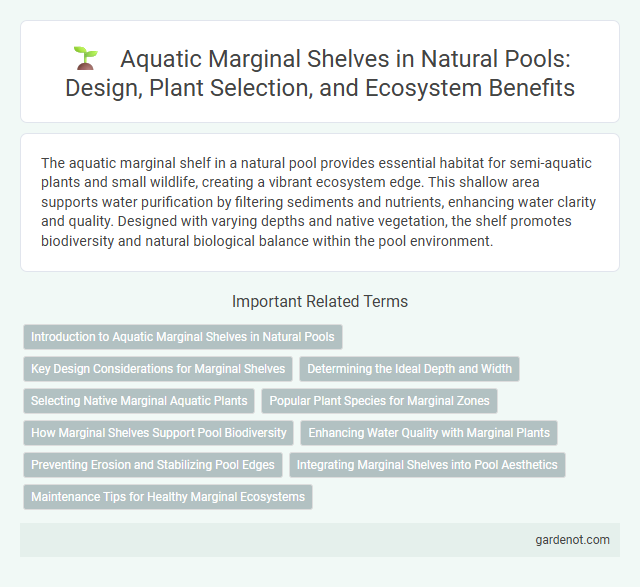The aquatic marginal shelf in a natural pool provides essential habitat for semi-aquatic plants and small wildlife, creating a vibrant ecosystem edge. This shallow area supports water purification by filtering sediments and nutrients, enhancing water clarity and quality. Designed with varying depths and native vegetation, the shelf promotes biodiversity and natural biological balance within the pool environment.
Introduction to Aquatic Marginal Shelves in Natural Pools
Aquatic marginal shelves in natural pools serve as shallow zones that support diverse plant life, enhancing biodiversity and water quality. These shelves act as transitional habitats where emergent and submerged vegetation thrive, providing shelter for aquatic organisms and stabilizing sediment. Integrating well-designed marginal shelves contributes to the ecological balance and aesthetic appeal of natural swimming pools.
Key Design Considerations for Marginal Shelves
Aquatic marginal shelves in natural pools require careful consideration of water depth, substrate selection, and plant species to ensure effective filtration and habitat diversity. The shelf must maintain shallow depths between 15-45 cm to support emergent aquatic plants while preventing sediment buildup and promoting water circulation. Proper design includes gradual slopes and diverse planting zones to balance ecological function with aesthetic appeal.
Determining the Ideal Depth and Width
The ideal depth of an aquatic marginal shelf in a natural pool typically ranges from 15 to 45 centimeters, allowing for optimal plant growth and water filtration while supporting diverse aquatic life. Width should be sufficient to accommodate emergent plants such as water irises and sedges, generally between 30 to 60 centimeters, ensuring effective nutrient uptake and habitat provision. Maintaining these depth and width parameters enhances biological filtration, stabilizes the pool ecosystem, and improves overall water quality.
Selecting Native Marginal Aquatic Plants
Selecting native marginal aquatic plants for the aquatic marginal shelf is essential to support local biodiversity and ensure ecological balance in a natural pool. Native species such as Carex, Juncus, and Scirpus contribute to water filtration, provide habitat for wildlife, and stabilize the pool's edges against erosion. Prioritizing plants adapted to the local climate and hydrology enhances the sustainability and aesthetic integration of the natural pool ecosystem.
Popular Plant Species for Marginal Zones
Aquatic marginal shelves in natural pools commonly feature plant species such as Cattails (Typha latifolia), Pickerelweed (Pontederia cordata), and Water Iris (Iris pseudacorus) that thrive in shallow water and saturated soils. These plants provide essential habitat for wildlife, improve water quality through natural filtration, and stabilize the pool's edges against erosion. Incorporating native species like Sweet Flag (Acorus calamus) and Marsh Marigold (Caltha palustris) enhances biodiversity and supports a balanced aquatic ecosystem.
How Marginal Shelves Support Pool Biodiversity
Aquatic marginal shelves create vital transition zones between deep water and land, providing diverse habitats that support a wide range of flora and fauna in natural pools. These shallow areas enhance biodiversity by offering shelter, breeding grounds, and abundant nutrients for insects, amphibians, and aquatic plants. The presence of marginal shelves stabilizes the ecosystem, promoting ecological balance and fostering increased species richness in the pool environment.
Enhancing Water Quality with Marginal Plants
Aquatic marginal shelves play a crucial role in enhancing water quality by hosting a variety of marginal plants that naturally filter pollutants and absorb excess nutrients. Species such as pickerelweed, arrowhead, and water lilies stabilize sediment and reduce algae growth through nutrient uptake. These plants create a balanced ecosystem, promoting clear, oxygen-rich water essential for maintaining a healthy natural pool environment.
Preventing Erosion and Stabilizing Pool Edges
An aquatic marginal shelf enhances natural pool ecosystems by preventing erosion and stabilizing pool edges through the strategic planting of native vegetation. These plants develop root systems that bind soil particles, reducing sediment displacement caused by water movement. By creating a gradual transition between land and water, the shelf minimizes wave impact and maintains the pool's structural integrity over time.
Integrating Marginal Shelves into Pool Aesthetics
Aquatic marginal shelves enhance natural pools by seamlessly blending water and landscape, providing habitat for plants that improve water quality and create visual depth. These shelves support a diverse range of aquatic vegetation, contributing to the pool's ecological balance while adding texture and interest to the overall design. Integrating marginal shelves into pool aesthetics promotes a harmonious environment that mimics natural water bodies and elevates outdoor living spaces.
Maintenance Tips for Healthy Marginal Ecosystems
Regular removal of organic debris and excess algae from the aquatic marginal shelf prevents nutrient overload and maintains water clarity. Monitoring water pH and nutrient levels supports balanced plant growth, sustaining a diverse marginal ecosystem. Periodic inspection for invasive species helps preserve native aquatic plants, ensuring optimal habitat for beneficial microorganisms and wildlife.
Aquatic marginal shelf Infographic

 gardenot.com
gardenot.com